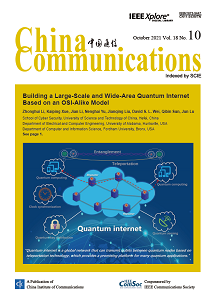COMMUNICATIONS THEORIES & SYSTEMS
Qingbo Zhai, Yong Bai, Dake Liu
2021, 18(10): 129-134.
This paper proposes a flexible eight-mode high parallel Galois SIMD ASIP(Application Specific Instruction Set Processor). It supports parallel executions of Gold,Scrambling, CRC, CC, Turbo, RM, PSS, SSS encoding LFSR (linear feedback shift registers) algorithms with high performance and flexibility. It can perform also general bit processing and m-sequence. Our design is based on proposed table conversion and a datapath for unified eight-mode encoding. Based on 28 nm digital CMOS technology, the total area is 0.177mm2 and the clock frequency can be up to 1 GHz. The throughputs of Gold, Scrambling, CRC32, CRC24, CRC16, CRC8, CC, Turbo are 64Gb/s, 64Gb/s, 128Gb/s, 168Gb/s, 256Gb/s, 512Gb/s, 3×80Gb/s, and 72Gb /s, respectively.
